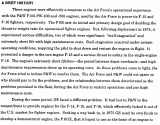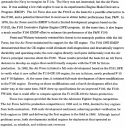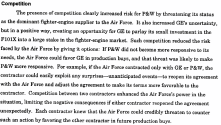You are using an out of date browser. It may not display this or other websites correctly.
You should upgrade or use an alternative browser.
You should upgrade or use an alternative browser.
US Military News, Reports, Data, etc.
- Thread starter tphuang
- Start date
They needed special attention on A and C too because they had to make the bomb bays identical between A,B and C. It was detrimental for the A and C version because the F-35B have limititions because of the lift fan.Lockheed Martin designed the F35 A and C before the B version. The USAF has extensive experience in operating single engine fighters so No the F35B did not have detrimental impact on the A and C. The USN also has experience with single engine aircraft.
Yes the B version did require special attention to accommodate the weight limits of the Lift system but that shouldn’t be a surprise. VTOL fighters are notoriously difficult to build.
Here's the U.S.M.C. doing their thang again...Yes I read and learned from his book. Can't say I enjoyed his book as I worked closely with Navy ship acquisition offices and saw all too closely the behaviors he described.
Early in the F-35 program I was asked about its operations aboard ships and I replied I couldn't speak to the airframe but ALIS wasn't going to work with our already over-subscribed SATCOM. And I hadn't known about the USAF background for ODIN.
The biggest surprise to me was how detrimental the USMC was to the airframe. Their requirements were put on a pedestal and never to be questioned. Which got me thinking about other USMC-driven acquisition failures: V-22, EFV (and soon ACV), perhaps CH-53K. And then there's Force Design 2030 and its LSM. I'm sure more than once Navy acquisition leadership wished the USMC was part of the Army when it came to platforms and weapons procurement.
As to CAIV (Cost As an Independent Variable) you can make it work (we did several times but on ACAT IVs only) but you have to move fast and produce incremental results rapidly to keep the momentum up. Slow down and all sorts of folks come out of the woodwork to drag you down. And the F-35 acquisition was slow.
So yeah his book was a bit pricey per page but high content value per page. Well worth it for me.
How come the Norwegian owners do anything with this shipyard for 2 decades?Not sure if this will have any impact on US defence production or naval output but I figured I would just link the story for those who are interested.
No word on plans for expansion or any sort of further investments as far as I can tell.
Yeah that's the LSM I referred to earlier. Notice the USN is the acquisition office not the USMC due to the size of the ship. And from what I've read the USN ain't excited about being stuck with the job. In my time we dealt with both USMC and SOF -- both assholes -- but SOF had money.
TerraN_EmpirE
Tyrant King
The A and C versions are rated for a number of weapon types in the internal bays the B is not. They made changes specifically to the B to reduce weight.They needed special attention on A and C too because they had to make the bomb bays identical between A,B and C. It was detrimental for the A and C version because the F-35B have limititions because of the lift fan.
Yes an engine that was over 20 years old by the time of F35. Thus far the F135 isn’t showing reliability issues but maintenance chain issues.The original F-16 engine from Pratt & Whitney was notoriously unreliable. To the point that several F-16s were retired early in their lifetime because of this. It was only after a contract was awarded to GE as a second engine supplier that Pratt & Whitney got off their butt and fixed the lingering issues in the engine design. Now the exact same thing happened with Pratt & Whitney.
Which won’t do dick. Those bands of radar don’t have the range or resolution. All you have is a so so track that could be the intruder or a flock of birds or a cloud. Farther F35 already has radar array in its wings.In the long term I expect aircraft to have smart skins. The radar might encompass the entire forward edge of the whole aircraft. This means longer wave radar is possible even on an aircraft airframe. Some claim the Su-35 and Su-57 already use the L-band radar arrays on their wings to do this.
No more so then you would expect from a fighter of its type. Remember this is a multirole machine.That provides you with lift sure but the centerbody of the aircraft is huge increasing frontal drag tremendously.
F16 is one of the most acrobatic aircraft of the 4th generation. Reality check here BVR attack is a thing. The only thing that has stopped it in the past as ROE. The whole Topgun dogfight really is cool but we are in the missile age. TVC is fun but unnecessary. Canards do the same thing as the large tail of many fighters. The super maneuver doesn’t factor unless you are in close.Maybe it has decent aerobatic performance. Compared with an F-16. But the world has moved past that. For example the Chinese have canards, the Russians have TVC, the F-35 has neither.
And you have to.And you rewrite the entire software stack in the process. That takes many years to do. And it shows.
Here is the thing F35 is an information centric fighter. It’s not like past fighters. Where you had an handful of sensors running separately. Its sensors and weapons management are integrated through the flight computer. The USAF has said they did a poor job on management in this. Now they are changing their strategy on missions systems to a more open source approach. Well true you can’t plug in any old weapons systems an APS like capability has been implemented so if a new weapon is added to the Aps store it’s good to go. F35 upgrades aren’t just done by maintenance crews but software updates. Yes like a Tesla it does “over the air updates”. Finally even more modern F15EX and F16C block 70 are already getting new computers and new flight control software.The opposite. They could have added the new software to an F-15 or F-16 variant and it would have entered service much earlier. Problems would start being debugged earlier. Instead they did what we in software call the "Big Bang" approach. They just code a whole mountain of software and then cross their fingers hoping it works.
It is crap at that. It has a monolithic software design. And it seems to be hard to add features without impacting the entire stack. The Gripen seems to surpass it at this capability. The user can actually install their own software modules and packages. In the F-35 you can't program and install anything yourself since the whole platform is locked down so only the vendor can do software upgrades.
Does this sound familiar?Yes an engine that was over 20 years old by the time of F35. Thus far the F135 isn’t showing reliability issues but maintenance chain issues.


...

The DoD is basically decreasing its bargaining power because of the single source nature of the F135 contract.
You use the long wave radar to detect regions of interest, which you then focus your targeting radar onto. AESA radar on X-band can then focus the radar cones there and increase the chance of detection.Which won’t do dick. Those bands of radar don’t have the range or resolution. All you have is a so so track that could be the intruder or a flock of birds or a cloud. Farther F35 already has radar array in its wings.
The MiG-29 had better aerobatic capabilities.F16 is one of the most acrobatic aircraft of the 4th generation.
So why did the F-22 have it then? They just added it for kicks?The whole Topgun dogfight really is cool but we are in the missile age. TVC is fun but unnecessary.
It just was not included in the F-35 for cost cutting.
Or in other words they don't do the same thing as the tail.Canards do the same thing as the large tail of many fighters. The super maneuver doesn’t factor unless you are in close.
As does the Su-35 and a number of other modern fighters. It was impossible to do this in the first place in 1970s era designs because the computational power was simply not enough to integrate all those capabilities. The fact they had flight computers made with ICs at all was due to careful design optimization. Breaking the problems up into chunks that disparate custom hardware systems could solve.Here is the thing F35 is an information centric fighter. It’s not like past fighters. Where you had an handful of sensors running separately. Its sensors and weapons management are integrated through the flight computer.
I am not that much of a fan of over the air updates on combat aircraft. It just seems like a one way trip to getting your weapons platform hacked.Well true you can’t plug in any old weapons systems an APS like capability has been implemented so if a new weapon is added to the Aps store it’s good to go. F35 upgrades aren’t just done by maintenance crews but software updates. Yes like a Tesla it does “over the air updates”. Finally even more modern F15EX and F16C block 70 are already getting new computers and new flight control software.
TerraN_EmpirE
Tyrant King
The issue for the maintenance chain is they it’s not finished being built yet and Covid didn’t help on that.Does this sound familiar?
View attachment 131353
View attachment 131356
...
View attachment 131358
The DoD is basically decreasing its bargaining power because of the single source nature of the contract.
Sure except the X band radar still can only operate in side its capability. The X band will still only see the intruder if it’s within the range of detection.You use the long wave radar to detect regions of interest, which you then focus your targeting radar onto. AESA radar on X-band can then focus the radar cones there and increase the chance of detection.
Until it’s armed. Once you start adding weapons, pods and drop tanks like all fourth generation fighters it becomes more and more sluggish. Besides the real limitations are on the pilots. F16s are already flying at the edge of human endurance.The MiG-29 had better aerobatic capabilities.
No it wasn’t included as the F35 was optimized more for multiple role missions at lower altitude. It was looked at for F35 but it was ditched primarily as it wasn’t deemed necessary are would have added additional weight.So why did the F-22 have it then? They just added it for kicks?
It just was not included in the F-35 for cost cutting.
F22 was designed with TVC and its high performance due to a higher altitude more air to air mission base. It operates more like a fourth generation in many ways. With a more primitive system.
Yet neither J10 or Eurofighter have tails they have delta wings. TVC augments inputs form the control surfaces and though there have been demonstrators with both Canards and tails most choose one or the other.Or in other words they don't do the same thing as the tail.
Not to the same degree as F35 and F22 come with theses systems baked in. And F35 even more so. And with fifth generation fighters everything has to fit inside the mold lines. So bolting on pods just doesn’t work.As does the Su-35 and a number of other modern fighters. It was impossible to do this in the first place in 1970s era designs because the computational power was simply not enough to integrate all those capabilities. The fact they had flight computers made with ICs at all was due to careful design optimization. Breaking the problems up into chunks that disparate custom hardware systems could solve.
That depends where on how the update is delivered and the software involved.I am not that much of a fan of over the air updates on combat aircraft. It just seems like a one way trip to getting your weapons platform hacked.
This back-and-forth around the F-35 is kinda interesting but doesn't rebut my essential argument:
And that's what Bill Sweetman's short, readable, fact-filled book explained.
From my past perspective dealing with them, if the USMC wants an aircraft then buy something the Navy or Army have already fielded. They were a difficult customer with an empty wallet.
The F-35 acquisition program might not have succeeded but the rigid adherence to USMC STOVL requirements ensured its failure. The laws of physics guaranteed it.The unbounded costs of F-35's acquisition and operational failures are blighting the "air dominance" future, just as Bill Sweetman explained.
And that's what Bill Sweetman's short, readable, fact-filled book explained.
From my past perspective dealing with them, if the USMC wants an aircraft then buy something the Navy or Army have already fielded. They were a difficult customer with an empty wallet.
It is perfectly doable to have a joint aircraft for the Air Force and Navy. There are good examples of this like the F-4 Phantom.
You just design the aircraft for the Naval requirement, and then you make a simplified version for the Air Force if required.
But putting the VTOL for the Marines in the same program was simply a step too far.
You just design the aircraft for the Naval requirement, and then you make a simplified version for the Air Force if required.
But putting the VTOL for the Marines in the same program was simply a step too far.
